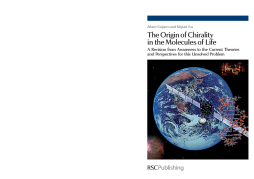
Additional Information
Book Details
Abstract
This book provides an interdisciplinary review of one of the great unsolved mysteries that has fascinated scientists for over 150 years: the origin of chirality in biomolecules. It was Pasteur who first initiated the search for a deterministic theory to explain the 'handedness' of biomolecules. His theory, that a 'dissimetric' force was involved, was correct in essence but he never saw the fruits of his labour. Current thinking tells us that asymmetry in the universe has its origins in the forces that unfolded after the Big Bang and, more specifically, the weak force. Being 'left handed', the weak force imprinted its signature on the evolving Universe. However, at the molecular level, the weak force does not provide a straightforward explanation of biomolecular homochirality. In fact, it is yet to be proved beyond doubt that a causal link exists at all. Many alternative theories have been put forward, some of them resting on solid ground, but all lacking definitive experimental evidence to back them up. Some postulate that the handedness of molecules in the biosphere arose by chance but this is hard to test. Others rely on discovering life on similar planets and making comparisons with Earth. Alternative theories have emerged from a range of backgrounds including geology, biology, chemistry, physics and astronomy. Current advances in fields as diverse as space exploration, prebiotic chemistry and high-energy physics may help to provide an answer. Important pieces of information will come from observations at the two frontiers of science: outer space and the subatomic world. Observation of distant planets, galaxies, and even actual sampling of celestial objects from beyond the solar system are projects currently underway. At the other end of the spectrum, there are experiments that study the elemental properties of matter, such as symmetry, and interactions with the fundamental forces. All these efforts will render their fruits soon. This volume unifies all the theories of the origin of biomolecular homochirality together in one source. The various chapters focus on chance mechanisms, physical forces such as the 'weakinteraction', fluid dynamics, amplification of chirality, the organic contents of meteorites and comets and, finally, the physical view of an intrinsically asymmetric universe. This complete, interdisciplinary review of an intriguing subject condenses a large and disparate range of contributions from journals in almost every scientific field. The various theories have been organized, interrelated and explained in a unified way. One of the book's strengths is its extensive use of graphic material to aid understanding the many subjects covered. It is fundamental, comprehensive and structured to be accessible for educational purposes.
Albert Guijarro received his MSc and PhD from the University of Alicante. He then spent three years at the University of Nebraska before returning to Alicante where he became Associate Professor in 2003. His current research interests are in the field of physical organic chemistry, specifically in the study of highly reduced anionic electron systems. He is co-author of 32 papers, has supervised four PhD students, and has participated in/directed numerous research projects. He is a research member of the ISO (Institute of Organic Synthesis) in Alicante and co-founder of MEDALCHEMY, S.L. Miguel Yus is based at the University of Alicante where he is currently head of the Organic Synthesis Institute (ISO). He has been visiting professor at various institutions including ETH-Zentrum and the Universities of Oxford, Harvard, Uppsala, Tucson, Okayama, Paris and Strasbourg. Professor Yus is on the Advisory Board of numerous learned journals and is Regional Editor of Letters in Organic Chemistry. He is co-author of over 400 papers, has given more than 150 lectures and supervised 43 PhD students. He has received accolades including the Japan Society for the Promotion of Science Prize, the French-Spanish Prize of the SocietÚ Franþaise de Chimie, the C.A. Stiefvater Memorial Lecture Award, the Nagase Science and Technology Foundation fellowship, and the Cellchem Lectureship. He is co-founder of MEDALCHEMY, S.L.
